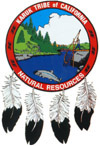
Merrill Fuels Reduction
Project Completed
Harold Tripp
Fire Coordinator/Cultural Resources Specialist
Karuk Tribe
|
|
|
Harold Tripp |
|
For the last seven weeks, the Department of Natural Resources Hazardous Fuels Reduction Crew has worked up the Salmon River on the Merrill Creek Hazard Fuel Reduction Project (located at the foot of Offield Mountain). The funding to make this project possible came from the Siskiyou County Resource Advisory Committee (RAC) and the Six River National Forest. Through government-to-government negotiations between the Karuk Tribe and the US Forest Service an agreement was formed for the Tribe to complete the project. Based on qualifications, five (5) members of the Karuk 1 Fire Crew were selected to complete the project. The objective of the project was to protect our communities from catastrophic wildfire by gathering up dead fuels, removing ladder fuels, pulling poison oak and coyote vine from trees, and removing overgrown vegetation from the forest floor. The Karuk People, are “fix the world people” and it is our religious and cultural responsibility to manage the forest so it is healthy enough to provide sustainable natural resources. Our vision in our Hazard Fuel Reduction Program is to imagine an old growth forest in a closed canopy environment and work to shape the landscape into that vision. The only way for this vision to become a reality in our forests today is to reduce the fuels that have overgrown for the last several decades.
By cutting back the overgrowth and
reducing fuel loading, we will ensure healthy populations of
basket-making materials and medicinal plants, while opening new land for
wildlife to forage. When fuels are reduced we may be able to begin the
fire regimen of our ancestors, who traditionally used
As a young boy I remember being in old
growth forests with my grandfather; many of these areas are now
overgrown conifer forests instead of the diverse hardwood forests from those
years past. We strive to shift from the current system that manages
exclusively for conifers, to a system that is managing instead for a more
healthier diverse forest. We hope to get back to those productive,
diverse old growth forests through the hard work and dedication of our
Tribal Fuels Reduction Crews. |